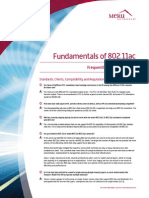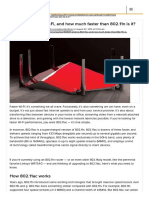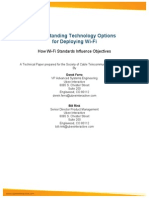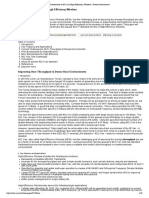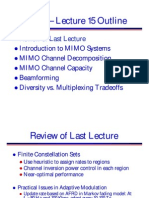0 ratings0% found this document useful (0 votes)
53 views802.11ac Action Plan:: A Network-Readiness Checklist
802.11ac Action Plan:: A Network-Readiness Checklist
Uploaded by
a_sahairequirements for 802.11ac
Copyright:
Attribution Non-Commercial (BY-NC)
Available Formats
Download as PDF, TXT or read online from Scribd
802.11ac Action Plan:: A Network-Readiness Checklist
802.11ac Action Plan:: A Network-Readiness Checklist
Uploaded by
a_sahai0 ratings0% found this document useful (0 votes)
53 views9 pagesrequirements for 802.11ac
Original Title
Requirements for 80211 Ac
Copyright
© Attribution Non-Commercial (BY-NC)
Available Formats
PDF, TXT or read online from Scribd
Share this document
Did you find this document useful?
Is this content inappropriate?
requirements for 802.11ac
Copyright:
Attribution Non-Commercial (BY-NC)
Available Formats
Download as PDF, TXT or read online from Scribd
Download as pdf or txt
0 ratings0% found this document useful (0 votes)
53 views9 pages802.11ac Action Plan:: A Network-Readiness Checklist
802.11ac Action Plan:: A Network-Readiness Checklist
Uploaded by
a_sahairequirements for 802.11ac
Copyright:
Attribution Non-Commercial (BY-NC)
Available Formats
Download as PDF, TXT or read online from Scribd
Download as pdf or txt
You are on page 1of 9
A Farpoint Group Technical Note
Document FPG 2012-779.2
April 2013
802.11ac Action Plan:
A Network-Readiness Checklist
Farpoint Group Technical Note April 2013
802.11ac: A Network-Readiness Checklist
2
e should state, right up front, that products based on the upcoming IEEE
802.11ac wireless-LAN (WLAN) standard are indeed going to dominate the
enterprise wireless local-area network landscape. But as is often the case with
new technologies, the hype surrounding the initial availability of .11ac products is
running, to our thinking, anyway, a bit ahead of reality. And thats OK, as the schedule
ultimately involved here enables enterprise network planners, managers, and operations
staff sufficient time to devise a framework for evaluating the features and benefits of
802.11ac, and especially for establishing a strategy and plan to roll out .11ac
infrastructure within their organizations the subject of this Farpoint Group Technical
Note.
802.11ac: Whats New and Important
The IEEE 802.11ac standard, the latest in a long line of enhancements to both PHY and
MAC that can trace their roots back to the start of the project in 1991 and the first
standard in 1997, is still under development and completion is not anticipated until late
2013. Similarly, the Wi-Fi Alliance, which assumes the role of specifying and certifying
interoperability, is now just beginning work on 802.11ac certification. Continuing with
what has become a tradition, however, and as was the case with both 802.11g and .11n,
draft products are appearing in the marketplace well in advance of the completion of
work by either organization noted above. Demand here is being driven, of course, by the
fundamental appeal of gigabit-class wireless LANs residential-class products claiming
1.3 Gbps are already on the market, and the standard as anticipated will specify numerous
levels of PHY throughput from 6.5 Mbps all the way to 6.93 Gbps. While we do not
anticipate seeing any products even approaching such lofty levels of performance
anytime soon (see Table 1), and ignoring the fact that the historical and regardless
significant gap between peak PHY rates and realizable Layer-7 performance will
continue to exist (our own tests of early .11ac products to date bear this out), the appeal
remains obvious. But while 802.11ac will indeed eventually replace todays 802.11n
networks, such is a number of years off. Well return to this point below, but suffice it to
say that we continue to encourage the purchase of 802.11n solutions for the time being.
802.11ac itself is more evolutionary than revolutionary, building on what were indeed
revolutionary technologies in 802.11n, most notably MIMO. Among the key
technological innovations in 802.11ac are wider radio channels (80 MHz., and eventually
to 160 MHz. in some implementations), standard beamforming, improved modulation
Mobile Device/Streams 20 MHz. 40 MHz. 20 MHz. 40 MHz. 80 MHz.
Smartphone (one stream) 72.2 150.0 86.7 200.0 433.3
Tablet (two streams) 144.4 300.0 173.3 400.0 866.7
Notebook (three streams) 216.7 450.0 288.9 600.0 1300.0
802.11n 802.11ac
W
Table 1 Comparative peak performance in Mbps of 802.11n and 802.11ac for common
numbers of spatial streams and channel sizes (in MHz.). We expect that single- and two-
stream clients will dominate at least initially, as will 40- and 80-MHz. channels. Source: IEEE.
Farpoint Group Technical Note April 2013
802.11ac: A Network-Readiness Checklist
3
efficiency (potentially resulting in much higher throughput), and even multi-user MIMO
the ability to transmit individual, unique data streams to multiple receivers
simultaneously. But, to keep things simple here, 802.11ac is primarily about improving
reliability, throughput, and overall capacity just as was the case with 802.11n.
What Should the Enterprise Do Now?
Its important to point out here that improvements in WLAN performance in enterprise
applications will rarely be evaluated on the basis of end-to-end throughput alone. Indeed,
while we can expect three-stream, 80-MHz. 802.11ac to yield on the order of 500 Mbps
at Layer 7, organizational deployments are much more concerned with overall reliability
and especially capacity. This means meeting the diverse needs of a large and increasing
number of users with a similarly growing number of devices per user (driven in large
measure by todays broadening shift to BYOD) and with a robust mix of application
demands, and not simply provisioning the maximum possible point-to-point throughput.
And many if not most .11ac-equipped client devices over the next few years will support
only one or two spatial streams still a big boost in potential performance, but certainly
not pushing the limits of either 802.11ac or existing gigabit-Ethernet switch ports.
Note also that simply deploying two 802.11n APs (or .11n radios within a single AP) on
distinct 40-MHz. channels yields roughly the same effective capacity as, and only slightly
less spectral efficiency than, a single 80-MHz. .11ac radio, all other parameters being
equal. Given the lack of .11ac clients today, and, as we expect the limited availability of
these clients to persist for some time (see An 802.11ac Timeline, below), continued
deployments of 802.11n are therefore recommended. As is always the case, however,
such deployments must be evaluated in terms of return on investment (ROI), this being of
course financial but primarily in terms of enhanced end-user productivity. As we have
often remarked, APs are cheap, and users are expensive. Continuing with deployments of
802.11n resulting in improved productivity today, then, is likely the best use of funds
dedicated to the wireless LAN for the time being, rather than saving these for an eventual
upgrade to 802.11ac. As a general rule, we recommend that if ROI, however quantified,
can be demonstrated for additional deployments of 802.11n over the next two years, then
such deployments should proceed without delay.
But since the deployment of 802.11ac essentially everywhere is indeed inevitable, it is
also vital that a readiness plan for the enterprise network overall be in place in advance of
the availability of products based on 802.11ac. The network-readiness checklist thus
required should include all of the following activities:
Perform a wired-network audit We do not expect that 802.11ac as typically
deployed (three stream, 80-MHz. channels) will exceed the capacity of ports on
gigabit-Ethernet switches. We do, however, recommend that future switch
deployments include at least ten-gigabit uplinks from the switch towards the
network core, not for connecting APs so as to avoid traffic bottlenecks at the
switch itself. New cable installations where required should pull at least two
Farpoint Group Technical Note April 2013
802.11ac: A Network-Readiness Checklist
4
uplink cables to every switch unless fiber is used. And while we expect
many .11ac APs to operate on 802.3af power over Ethernet (PoE), we recommend
that switches for new deployments provision 802.3at just in case and for future
contingencies. And, finally, its important to look for potential performance
problems in the network core and especially in backhaul to the Internet. Current
network-management console information can be invaluable in monitoring and
analyzing any potential issues here. Keep in mind that, no matter when one
upgrades to 802.11ac, traffic demands can be expected to continue to grow at a
significant pace regardless. Capacity modeling and planning, then, should extend
well into the future beyond any anticipated initial deployment or upgrade.
Establish a coexistence/migration plan Except in rare cases, there should be no
need for a rip-and-replace approach to an 802.11ac upgrade. Indeed, Farpoint
Group recommends a phased, staged, non-disruptive strategy wherever possible.
We suggest that a good place to start with .11ac will be a deployment in a new
physical space, one not previously covered by Wi-Fi. This will create an
opportunity for careful evaluation, experience, and tuning as required. The
optimal deployment strategy regardless will likely involve setting aside a 40- or
perhaps 80-MHz. channel just for 802.11ac. Continuity for existing .11n clients is
vital, and, as we doubt that optimal performance will be achieved by enabling
backwards compatibility for .11ac APs (i.e., provisioning .11n and .11ac on the
same AP and channel simultaneously), existing .11n APs can be left in place.
Finally, given the increasing use of direct-forwarding architectures, wherein
traffic to and from APs need not flow through a controller, controller upgrades
may not be required. However, as controllers continue to evolve in terms of new
features, upgrades here may regardless be desirable in many deployments.
Examine current Wi-Fi channel utilization The potential for some re-farming of
channel allocations must be considered. This may very well be automatic through
the adaptive radio management features of a particular Wi-Fi management
console, but we still recommend verification with appropriate tools. We do not
anticipate any significant issues here in most cases, however, as the 5 GHz. bands
have been notoriously underutilized in most venues. But it may be desirable to
operate 802.11ac in 40 MHz. channels in some locations, especially during initial
deployments throughput will be lower in this case, but the potential for
disruptions minimized. And we would suggest that 160-MHz. channels should not
be considered at this time due what we believe will be an extended period before
compatible client devices become available, as well as the very limited number of
possible channels and their potential impact on existing channels. See Figure 1 for
more on Wi-Fi channels in the 5 GHz. bands.
Consider operations and network-management requirements Farpoint Group
believes that management-console functionality is today critical to the success of
any given enterprise-class Wi-Fi deployment (see Figure 2). We therefore
recommend meeting with ones vendor to discuss both the anticipated 802.11ac
upgrade, as well as what features will be available to smooth and enhance
Farpoint Group Technical Note April 2013
802.11ac: A Network-Readiness Checklist
5
ongoing operations. .11ac also creates a great opportunity, we believe, to consider
deploying unified wired/wireless management another interesting topic for
discussions with vendors, as well as to review current and required assurance,
compliance, and analytics functionality.
Apply a dense-deployment strategy We have advocated deploying APs with an
emphasis on capacity rather than coverage alone since the early days of
enterprise-class wireless LANs well over a decade ago. And, as we believe that
optimal 802.11ac performance will be obtained by keeping the distance between
endpoints as short as possible, a dense-deployment strategy continues to be our
recommendation with 802.11ac. Even with the advances inherent in 802.11ac,
wider channels may result in less effective range due to the spreading of RF
power across more spectrum, and a greater potential for interference. Ever-
increasing device density with correspondingly-increasing demands for service
will regardless continue to motivate dense deployments irrespective of any
specific WLAN technology.
Begin a budgetary analysis Finally, and this goes without saying, updating
budgetary models is also advisable. While some current modular .11n/.11ac
designs have appeared at the upper end of current AP prices, we do not anticipate
that mainstream, dedicated, enterprise-class 802.11ac APs will be much more
expensive than .11n APs. We also expect that investments in improved
management consoles will yield positive benefits in the operating expense
calculation. We continue to advise capital expenditures that minimize OpEx.
1
4
0
1
3
6
1
3
2
1
2
8
1
2
4
1
2
0
1
1
6
1
1
2
1
0
8
1
0
4
1
0
0
1
6
5
1
6
1
1
5
7
1
5
3
1
4
9
6
4
6
0
5
6
5
2
4
8
4
4
4
0
3
6
IEEE channel #
20 MHz
40 MHz
80 MHz
5170
MHz
5330
MHz
5490
MHz
5710
MHz
5735
MHz
5835
MHz
160 MHz
1
4
0
1
3
6
1
3
2
1
2
8
1
2
4
1
2
0
1
1
6
1
1
2
1
0
8
1
0
4
1
0
0
6
4
6
0
5
6
5
2
4
8
4
4
4
0
3
6
IEEE channel #
20 MHz
40 MHz
80 MHz
5170
MHz
5330
MHz
5490
MHz
5710
MHz
160 MHz
!""#$%&%'()*#+,(-.$/0%1#&-+''%)#2334#&$%+5'6#
+11/5.'+)#784#38#+'1#98#:;0#&-+''%)<#/'#(-%#=>##
=>#
?,$.@%4#
A+@+'4#
B).C+)#
Figure 1 Channel plan for the 5-GHz. unlicensed bands. Note the limited availability of 80-
MHz., and especially 160-MHz., channels. Source: octoScope.
Farpoint Group Technical Note April 2013
802.11ac: A Network-Readiness Checklist
6
An 802.11ac Timeline
While, as noted above, some residential-class, pre-standard 802.11ac products are now
available, Farpoint Group believes that it will be at least mid-2013 before we start to see
meaningful numbers of both enterprise-class infrastructure and client products. These
will primarily be two-and three-stream, 40- and 80-MHz. APs, and one- and two-stream
client adapters.
A full list of our predictions for product and market timing can be seen in Figure 3. Of
greatest significance is our belief that 802.11n products will continue to outsell 802.11ac
until 2015, and that we will not see wholesale replacement of 802.11n networks until
around 2018. Indeed, we believe that 802.11n, properly deployed, will continue to
provide service well into the next decade in many venues.
The 802.11ac Action Plan
As the requirements for 802.11n are well-established today, the purpose of this document
is to present a checklist of important activities required to prepare for the eventuality of
802.11ac no matter when a given enterprise begins deployment of this next step in the
evolution of what has become the default and even primary access for many if not most
users in organizations everywhere. A quick review of our suggestions can be found in
Summary of Recommendations sidebar, below. None of these items represents any
significant departure from what successful IT operations have been doing for years, but
such planning today has a greater importance than ever given the mission-critical status
that wireless has achieved in the enterprise.
Figure 2 An example of the information obtained from a management console. This data is
invaluable in tuning and monitoring any WLAN deployment, and will be critical in optimizing
initial installations of 802.11ac. Source: Aruba Networks.
Farpoint Group Technical Note April 2013
802.11ac: A Network-Readiness Checklist
7
Even as we anticipate significant performance improvements across the dimensions noted
in this document, we also expect that enterprise-class vendors will take advantage of the
advent of 802.11ac to introduce advances in their overall system architectures and
implementations. We must stress here, as we have in previous documents, that elements
such as AP and WLAN system architecture and management will be just as important to
organizational success as basic technologies like 802.11ac. This is a very important point:
while its possible, for example, to add-on an 802.11ac radio to some 802.11n access
points, the best price/performance and perhaps even the best performance overall is much
more likely to be achieved with enterprise-class products engineered end-to-end for
802.11ac. These will, again, begin to appear during 2013.
Nonetheless, we are looking forward to meaningful improvements in overall wireless
performance, especially in terms of capacity, with 802.11ac. We must caution again that
extending range will be desirable in only a restricted set of cases, and that dense
deployments focused on capacity will continue to be a key to success. And we expect to
see large numbers of single- and two-stream .11ac clients as handsets and tablets continue
on their path to becoming the dominant access devices in the majority of enterprise
applications. The deployment of 802.11ac for gigabit-class service, then, will be
relatively rare for at least the next few years.
Regardless, 802.11ac is clearly now the trend for the future. While upgrades will take
some time, Farpoint Group believes that it is important to begin preparing the
organizational network for the arrival of this new technology. Properly planned and
executed, this transition can be easy for network operations staff and smooth and
transparent for users.
2013 2013 2018 2012
8eplacemenL of
802.11n
llrsL 802.11ac
producLs
llrsL enLerprlse-class
producLs
llrsL embedded
producLs
SLandard nlshed
Wl-ll Alllance speclcauon
Crlucal mass - enLerprlse lnfrasLrucLure
Crlucal mass - cllenLs
Figure 3 A projected timeline for 802.11ac. While 2013 will see significant product
announcements and the completion of required technical work, sales of .11ac clients and
APs exceeding those of .11n (critical mass) will not occur until 2015, and wholesale
replacement of 802.11n will be quite rare before 2018. Source: Farpoint Group.
Farpoint Group Technical Note April 2013
802.11ac: A Network-Readiness Checklist
8
Summary of Recommendations
Deploy 802.11n in any situation where a demonstrable need and business case
exists today
Plan switch upgrades as required with 10 Gb uplinks
Consider pulling two Cat 6 cables to new switch locations
Plan for an 802.11at PoE requirement
Perform a budgetary analysis
Explore network management requirements and opportunities with selected
vendor
Verify core-network and backhaul capacity
Consider a greenfield deployment of 802.11ac, rather than a replacement of
802.11n, as a first step with the technology
Augment existing 802.11n deployments with 802.11ac on separate channels
Consider deploying 802.11ac initially using 40-MHz. channels so as to avoid
disrupting operations and the current channel plan
Ignore the use of 160-MHz. channels for the time being
Continue to pursue a dense-deployment strategy capacity remains the
overriding objective
Figure 3 A Network-Readiness Checklist for 802.11ac. Source: Farpoint Group
Ashland MA USA
508-881-6467
www.farpointgroup.com
info@farpointgroup.com
The information and analysis contained in this document are based upon actual testing and publicly-
available information sources believed to be correct as of the date of publication. Farpoint Group
assumes no liability for any inaccuracies that may be present herein. Revisions to this document may
be issued, without notice, from time to time.
Copyright 2013 All rights reserved
Permission to reproduce and distribute this document is granted provided this copyright notice is
included and that no modifications are made to the original.
You might also like
- Weber, Beckmann - AschenbrödelDocument15 pagesWeber, Beckmann - Aschenbrödelroot80100% (1)
- Russian Transport: Erika ShefferDocument12 pagesRussian Transport: Erika ShefferAlcindorLeadon0% (1)
- Software-Defined Networks: A Systems ApproachFrom EverandSoftware-Defined Networks: A Systems ApproachRating: 5 out of 5 stars5/5 (1)
- Motoroal - 802.11ac White PaperDocument10 pagesMotoroal - 802.11ac White PaperL1architectNo ratings yet
- Frequently Asked QuestionsDocument8 pagesFrequently Asked QuestionsgesperNo ratings yet
- White Paper: 802.11ac Survey: Gigabit Wifi Has ArrivedDocument9 pagesWhite Paper: 802.11ac Survey: Gigabit Wifi Has ArrivedAndyNo ratings yet
- 802.11ac: The Fifth Generation of Wi-Fi: Technical White PaperDocument25 pages802.11ac: The Fifth Generation of Wi-Fi: Technical White PaperSubash ShresthaNo ratings yet
- 2012 Faq 802.11ac Standards Clients Compatibility RegulationsDocument0 pages2012 Faq 802.11ac Standards Clients Compatibility Regulationsjavierdb2012No ratings yet
- 802 11acDocument29 pages802 11acHarshaNo ratings yet
- 802.11n Wireless Technology Overview: Deploying The Next Generation of High Performance WirelessDocument7 pages802.11n Wireless Technology Overview: Deploying The Next Generation of High Performance WirelessswalayNo ratings yet
- Next Generation 802.11ac SOLUTION: Fact SheetDocument2 pagesNext Generation 802.11ac SOLUTION: Fact Sheetducquang89No ratings yet
- What Is 802.11ac Wi-Fi, and How Much Faster Than 802Document17 pagesWhat Is 802.11ac Wi-Fi, and How Much Faster Than 802uoejduyelasdeNo ratings yet
- How To Cable 802.11n Wireless Access Points: White PaperDocument5 pagesHow To Cable 802.11n Wireless Access Points: White Paperabul abbasNo ratings yet
- What Is 802.11acDocument5 pagesWhat Is 802.11acahmed sheikhNo ratings yet
- 802.11ac Overview: Why Is 802.11ac Needed?Document4 pages802.11ac Overview: Why Is 802.11ac Needed?javierdb2012No ratings yet
- Cabling Infrastructure For Next Generation Wireless Access Points, 802.11ac and BeyondDocument2 pagesCabling Infrastructure For Next Generation Wireless Access Points, 802.11ac and BeyondCarlos Buznego NiochetNo ratings yet
- 802.11ac The Fifth PDFDocument20 pages802.11ac The Fifth PDFjamal abkiNo ratings yet
- 802.11ac: The Fifth Generation of Wi-Fi: Technical White PaperDocument20 pages802.11ac: The Fifth Generation of Wi-Fi: Technical White PaperchopanalvarezNo ratings yet
- Network Impact of 802Document8 pagesNetwork Impact of 802Wajahat KhanNo ratings yet
- 802.11n Config On WLCDocument16 pages802.11n Config On WLCWaqas AkhtarNo ratings yet
- Groundwork For New Level Wireless Access WP-107113Document15 pagesGroundwork For New Level Wireless Access WP-107113embsbrNo ratings yet
- 7signal Wireless 802.11ac Migration Real World Best PracticesDocument17 pages7signal Wireless 802.11ac Migration Real World Best Practicesxaroxe5366No ratings yet
- 802.11 Overview PDFDocument8 pages802.11 Overview PDFSandeep PandeyNo ratings yet
- Wi-Fi Technology Note WF104: Migrating To 802.11n While Supporting Legacy 802.11b/g ApplicationsDocument6 pagesWi-Fi Technology Note WF104: Migrating To 802.11n While Supporting Legacy 802.11b/g Applicationsgamer08No ratings yet
- ST Paul'S University Nairobi CampusDocument8 pagesST Paul'S University Nairobi CampusQui BuiNo ratings yet
- 802.11 - Wi-Fi Standards and Speeds Explained - Network World PDFDocument6 pages802.11 - Wi-Fi Standards and Speeds Explained - Network World PDFTecnologia MasterNo ratings yet
- Mobile Computing Assignment: Submitted by Sakaanaa M 2017115583Document31 pagesMobile Computing Assignment: Submitted by Sakaanaa M 2017115583Sakaanaa MohanNo ratings yet
- Inside 802.11n Wireless LANsDocument16 pagesInside 802.11n Wireless LANsJosué JuniorNo ratings yet
- Migrating To 802.11n While Supporting Legacy 802.11b, G Applications (2006)Document6 pagesMigrating To 802.11n While Supporting Legacy 802.11b, G Applications (2006)Chiti ChoopayakNo ratings yet
- Wildpacket'S Guide To Wireless Lan Analysis: All Rights ReservedDocument18 pagesWildpacket'S Guide To Wireless Lan Analysis: All Rights ReservedHappyTzi TehNo ratings yet
- 802.11 StandardDocument3 pages802.11 StandardDaljit SinghNo ratings yet
- Designing and Building A Campus Wireless Network 2012 v2Document13 pagesDesigning and Building A Campus Wireless Network 2012 v2ulexoxNo ratings yet
- WP-802.11nPrimer OKDocument15 pagesWP-802.11nPrimer OKNoha AminNo ratings yet
- 2 OK - IEEE 802.11ax - High-Efficiency WLANsDocument9 pages2 OK - IEEE 802.11ax - High-Efficiency WLANsAndréNo ratings yet
- NBASE-T Ethernet Technology: Basis For The IEEE 802.3bz StandardDocument4 pagesNBASE-T Ethernet Technology: Basis For The IEEE 802.3bz StandardJosé Miguel Melgar RojasNo ratings yet
- What's The Difference Between IEEE 802.11af and 802.11ah - PDFDocument10 pagesWhat's The Difference Between IEEE 802.11af and 802.11ah - PDFsorinproiecteNo ratings yet
- Understanding Technology Options For Deploying Wi-Fi White PaperDocument43 pagesUnderstanding Technology Options For Deploying Wi-Fi White Paperophyx007No ratings yet
- Microsoft Word - IEEE 802.11ax QShineDocument6 pagesMicrosoft Word - IEEE 802.11ax QShinealewNo ratings yet
- 5G Vs WiFi 6Document14 pages5G Vs WiFi 6Bala JE/BSNLNo ratings yet
- Wireless.Access.Performance-CommScopeDocument15 pagesWireless.Access.Performance-CommScopeabery.auNo ratings yet
- 802.11n: Next-Generation Wireless LAN Technology: White PaperDocument13 pages802.11n: Next-Generation Wireless LAN Technology: White PapermanjunathbhattNo ratings yet
- 802.11n: Next-Generation Wireless LAN Technology: White PaperDocument13 pages802.11n: Next-Generation Wireless LAN Technology: White PaperALEXANDRE JOSE FIGUEIREDO LOUREIRONo ratings yet
- Cisco's Unified Wireless Solutions: Aduait Pokhriyal ID - No. 34915Document34 pagesCisco's Unified Wireless Solutions: Aduait Pokhriyal ID - No. 34915Aduait PokhriyalNo ratings yet
- WiFi Standards 802.11a B G N vs. 802.11acDocument3 pagesWiFi Standards 802.11a B G N vs. 802.11acDavid SofitaNo ratings yet
- Chapter 8. Wi-Fi 7 Network Planning - Wi-Fi 7 in Depth - Your Guide To Mastering Wi-Fi 7, The 802.11be Protocol, and Their DeploymentDocument43 pagesChapter 8. Wi-Fi 7 Network Planning - Wi-Fi 7 in Depth - Your Guide To Mastering Wi-Fi 7, The 802.11be Protocol, and Their DeploymentTuấn Minh NgôNo ratings yet
- Term Paper Synopsis - 1Document6 pagesTerm Paper Synopsis - 1psdNo ratings yet
- WLAN Intro:: Infrastructure Mode. Logically, An Ad-Hocconfiguration Is Analogous To A Peer-ToDocument11 pagesWLAN Intro:: Infrastructure Mode. Logically, An Ad-Hocconfiguration Is Analogous To A Peer-Tomurthy venkataNo ratings yet
- NTC/247 Wireless Lan Final DocumentDocument5 pagesNTC/247 Wireless Lan Final DocumentPamela SmitheyNo ratings yet
- 802 11axDocument10 pages802 11axtien nguyenNo ratings yet
- 2012 WP Ieee 802 11ac Understanding Enterprise Wlan Challenges PDFDocument0 pages2012 WP Ieee 802 11ac Understanding Enterprise Wlan Challenges PDFVenu MadhavNo ratings yet
- Ieee 802.16 and Wimax: Broadband Wireless Access For EveryoneDocument8 pagesIeee 802.16 and Wimax: Broadband Wireless Access For Everyonechaidar_lakareNo ratings yet
- Gigabit Wireless Lans: An Overview of Ieee 802.11ac and 802.11adDocument12 pagesGigabit Wireless Lans: An Overview of Ieee 802.11ac and 802.11adIulik BrumaNo ratings yet
- A Quantitative Analysis of 802.11 Ah Wireless StandardDocument4 pagesA Quantitative Analysis of 802.11 Ah Wireless StandardInternational Journal of Latest Research in Engineering and TechnologyNo ratings yet
- IEEE 802.11g: The New Mainstream Wireless LAN StandardDocument12 pagesIEEE 802.11g: The New Mainstream Wireless LAN StandarddeviNo ratings yet
- IEEE 802.11g New Draft Standard Clarifies Future of Wireless LANDocument5 pagesIEEE 802.11g New Draft Standard Clarifies Future of Wireless LANMukesh CoolNo ratings yet
- NI Intro To 802.11axDocument10 pagesNI Intro To 802.11axDaniel WongNo ratings yet
- The 40 Gigabit Ethernet Era in The EnterpriseDocument6 pagesThe 40 Gigabit Ethernet Era in The Enterprisesandeep11661No ratings yet
- Ieee 802.11ah: Advantages in Standards and Further Challenges For Sub 1 GHZ Wi-FiDocument5 pagesIeee 802.11ah: Advantages in Standards and Further Challenges For Sub 1 GHZ Wi-FiNithya BNo ratings yet
- 60GHz Technology for Gbps WLAN and WPAN: From Theory to PracticeFrom Everand60GHz Technology for Gbps WLAN and WPAN: From Theory to PracticeNo ratings yet
- CWNA Certified Wireless Network Administrator Study Guide: Exam CWNA-108From EverandCWNA Certified Wireless Network Administrator Study Guide: Exam CWNA-108No ratings yet
- Reconfigurable Radio Systems: Network Architectures and StandardsFrom EverandReconfigurable Radio Systems: Network Architectures and StandardsNo ratings yet
- Versatile Routing and Services with BGP: Understanding and Implementing BGP in SR-OSFrom EverandVersatile Routing and Services with BGP: Understanding and Implementing BGP in SR-OSNo ratings yet
- Survey of Localization TechniquesDocument30 pagesSurvey of Localization Techniquesa_sahaiNo ratings yet
- Resilient MPLS Rings: Draft-Kompella-Mpls-Rmr Kireeti Kompella Ietf 91Document11 pagesResilient MPLS Rings: Draft-Kompella-Mpls-Rmr Kireeti Kompella Ietf 91a_sahaiNo ratings yet
- The Path To 5G in Australia 03 August 2018 2Document28 pagesThe Path To 5G in Australia 03 August 2018 2a_sahai100% (3)
- NFV INF005v0112Document53 pagesNFV INF005v0112a_sahaiNo ratings yet
- Huawei Smart City Solution BrochureDocument10 pagesHuawei Smart City Solution Brochurea_sahaiNo ratings yet
- 3GPP Network ArchitectureDocument111 pages3GPP Network Architecturea_sahaiNo ratings yet
- Building The Environment For Building The Environment For The Things As A Service The Things As A ServiceDocument31 pagesBuilding The Environment For Building The Environment For The Things As A Service The Things As A Servicea_sahaiNo ratings yet
- Setting Value, Not Price - McKinsey & CompanyDocument15 pagesSetting Value, Not Price - McKinsey & Companya_sahaiNo ratings yet
- Skype - s1 Aug 2010Document340 pagesSkype - s1 Aug 2010a_sahaiNo ratings yet
- MIMO Andmimo Smart Antennas - July 2013 - FINALDocument42 pagesMIMO Andmimo Smart Antennas - July 2013 - FINALa_sahaiNo ratings yet
- 3GPP TS 29.274: Technical SpecificationDocument145 pages3GPP TS 29.274: Technical Specificationa_sahaiNo ratings yet
- 3B6B478B21CE493BF0C94F90F94B8C82Document19 pages3B6B478B21CE493BF0C94F90F94B8C82Rocky IrvanoNo ratings yet
- March 16, 2014 BulletinDocument4 pagesMarch 16, 2014 BulletinHtaung Za KyintNo ratings yet
- Just The Two of Us: by Bill Withers, Ralph Macdonald, William Salter Arranged by Nicholas CoccoDocument2 pagesJust The Two of Us: by Bill Withers, Ralph Macdonald, William Salter Arranged by Nicholas CoccoCarlão Musico100% (1)
- Ableton Live Tips and Tricks Part 4 PDFDocument100 pagesAbleton Live Tips and Tricks Part 4 PDFSergey VilkaNo ratings yet
- John A Donahue - Applying Experimental Archaeology To Ethnomusicology PDFDocument16 pagesJohn A Donahue - Applying Experimental Archaeology To Ethnomusicology PDFAlexMartínVidalNo ratings yet
- Tutira MainaDocument5 pagesTutira MainaJaiber Uribe ÚsugaNo ratings yet
- Kawaki_wo_Ameku_SHEETDocument8 pagesKawaki_wo_Ameku_SHEET李震原No ratings yet
- Lecture 15Document9 pagesLecture 15Hussain NaushadNo ratings yet
- 5IT01 01 Que 20170517Document20 pages5IT01 01 Que 20170517AsadNo ratings yet
- Oep 1200 DatasheetDocument2 pagesOep 1200 Datasheetriyanto_fisika5535No ratings yet
- Madras KannanDocument6 pagesMadras KannanLalitharam RamachandranNo ratings yet
- Class Viii English Annual Exam 2017 18Document5 pagesClass Viii English Annual Exam 2017 18S.Advith saiNo ratings yet
- LYRICS OF Hot and DangerousDocument2 pagesLYRICS OF Hot and DangerousPriya SharmaNo ratings yet
- Iwonder 1 - 4: Placement TestDocument7 pagesIwonder 1 - 4: Placement Testfatyma ezzahraNo ratings yet
- 02 IG4K TechnologiesDocument47 pages02 IG4K TechnologiesM Tanvir AnwarNo ratings yet
- Parental Involvement in Children's Independent Music LessonsDocument26 pagesParental Involvement in Children's Independent Music LessonsAyuNo ratings yet
- Loi Loi Krathong (English Version)Document2 pagesLoi Loi Krathong (English Version)Corazon SibalNo ratings yet
- Kid4m - Fa2 - HD U9 - Grammar FriendsDocument2 pagesKid4m - Fa2 - HD U9 - Grammar FriendsTrần NhànNo ratings yet
- Dont Let The Pigeon Drive The BusDocument29 pagesDont Let The Pigeon Drive The Busjoelyela100% (1)
- Aarati, Gurustotram & 108 Names in SanskritDocument2 pagesAarati, Gurustotram & 108 Names in SanskritQuizzer Suresh Kumar PinglayNo ratings yet
- Satellite Ommunication Previous Year University Question PapersDocument39 pagesSatellite Ommunication Previous Year University Question PapersShanmugapriyaNo ratings yet
- Sax BuscandoteDocument2 pagesSax BuscandoteKevin DazaNo ratings yet
- Blood BrothersDocument3 pagesBlood BrothersRamon AlturoNo ratings yet
- DancecvDocument3 pagesDancecvapi-310962329No ratings yet
- Russian Psalms Transliterated With Audio-Links 11-27-2014Document1,006 pagesRussian Psalms Transliterated With Audio-Links 11-27-2014David F MaasNo ratings yet
- Part 3 Artist and His MediumDocument62 pagesPart 3 Artist and His MediumyhannypalmariaNo ratings yet
- Fender HistoryDocument3 pagesFender HistoryKarl HummerNo ratings yet
- 1.8m MW PDFDocument4 pages1.8m MW PDFAmit Gorkhali100% (1)







